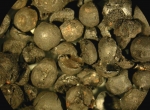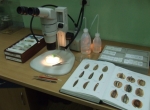Archaeobotany
Archaeobotany investigates the relationship between humans and the plant world in the past by analyzing plant remains recovered from archaeological contexts. It is a field of environmental archaeology which studies the relationship between the natural environment and human culture development in the past using input from archaeology, natural sciences, ethnography and history.
A. is a branch of botany which has been developing dynamically since the 19th century. Its research focus is on plant remains recovered from a culture deposit and from archaeological features: seeds and fruits, wood, rhizomes, bulbils, fragments of parenchyma from different organs, plant leaves, phytoliths, pollen grains and more. The survival of plant remains (subfossil remains) depends on the conditions prevailing in the archaeological site. Where the water table is high, or in an aquatic environment, the remains may be preserved by waterlogging (fig. 1.). As a result of an earlier contact with fire (natural fires, man-made fires started deliberately or by accident) charred plant remains (fig. 2.) may survive in an archaeological context. Plant tissue saturated with metal salts (for example tricalcium phosphate Ca3 (PO4)2.) may undergo mineralization. In conditions of a very dry climate or a special microclimate plant remains may become desiccated. Then, there is another type of plant material - impressions that survive on pottery or daub. Depending on the type of the fossilization process different elements of plant material may have been preserved: seeds of legumes survive perfectly well when charred but very few have such seed have been found preserved by waterlogging.
Archaeobotany specialists identify plant remains using their knowledge of plant morphology, anatomy and taxonomy. To correctly interpret plant remains recovered from archaeological sites the following factors are taken into account: the archaeological context, properties of the deposit that have a bearing on the survival of plant remains and the type of the fossilization process, co-occurrence of specific groups of species in the sample/deposit/archaeological feature; properties of plants such as their structure, biology, environmental requirements and properties, which would have made them useful to humans and resulted in decisions on their storage in the archaeological feature.
Today the scope of archaebotany research is very broad, with focus placed on problems such the origin, development and spread of cultivars and agriculture; use of biochemical and genetic studies to identify wild plant species ancestral to the early and the now existing cultivars; the uses of wild plants; the reconstruction of different forms of economic activity (construction, commerce, seasonality of occupation and some of the economic activities, healing, in worship; how the plant foods were obtained and consumed, methods of animal husbandry); the natural setting in which the people lived and the impact of settlement and economy during prehistory on the natural environment and on the processes of synantropization of flora and vegetation; this has been paralleled by improvements made in the methods of identifying subfossil materials, for instance, vegetative storage organs (bulbils, rhizomes), and studies made of the impact of taphonomic processes and methods of sample-taking on interpretation possibilities.
ML, MŚM, AP, MZ
Literature: C.A. Hastorf, V.S. Popper, Current Paleoethnobotany, Analytical Methods and Cultural Interpretations of Archaeological Plant Remains, The University of Chicago Press, Chicago and London, 1988; M. Lityńska-Zając, K. Wasylikowa, Przewodnik do badań archeobotanicznych, Poznań 2005; K. Wasylikowa, Co to jest Archeobotanika, Polish Botanical Studies Guidebook Series 11, 1994, p. 17-29; S. Jacomet, A. Kreuz, Archäobotanik, Aufgaben, Methoden und Ergebnisse vegetations- und agrargeschichtlicher Forschung, Verlag Eugen Ulmer Stuttgart, 1999; D.F. Dincauze, Environmental Archaeology, principles and practice, Cambridge University Press, 2000; M. Latałowa, Badania palinologiczne na stanowiskach archeologicznych, W: Dybova-Jachowicz S., Sadowska A. (eds.), Palinologia, Wydawnictwa Instytutu Botaniki PAN, Kraków, 2003, p. 308-312; D.R. Piperno, Phytoliths, A Comprehensive Guide for Archaeologists and Paleoecologists, Altamira Press, Oxford, 2006; M. Makohonienko, D. Makowiecki, Z. Kurnatowska (eds.), Studia interdyscyplinarne nad środowiskiem i kulturą w Polsce. Środowisko-Człowiek-Cywilizacja, tom I, Poznań, 2007; S. Jacomet, Plant macrofossil methods and studies: use in environmental archaeology, Encyclopedia of Quaternary Science, Amsterdam, 2007, s. 2384-2412.
-
 full resolution
full resolution
Fig. 1. Plant remains from an archaeological context preserved by waterlogging Photo K. Pińska.
-
 full resolution
full resolution
Fig. 2. Charred peas from an archaeological context. Photo M. Badura.
-
 full resolution
full resolution
Fig. 3. The work station of an archaebotany specialist. Photo K. Pińska.


